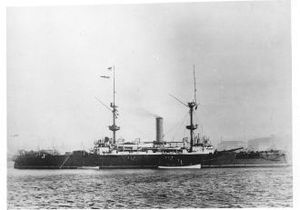Our website is made possible by displaying online advertisements to our visitors.
Please consider supporting us by disabling your ad blocker.
HMS Resolution (1892)
 HMS Resolution
| |
| History | |
|---|---|
| Name | Resolution |
| Builder | Palmers Shipbuilding and Iron Company, Jarrow |
| Cost | £875,522, plus £78,295 for guns |
| Laid down | 14 June 1890 |
| Launched | 28 May 1892 |
| Completed | November 1893 |
| Commissioned | 5 December 1893 |
| Decommissioned | 8 August 1911 |
| Fate | Sold for scrapping, 2 April 1914 |
| General characteristics [1] | |
| Class and type | Royal Sovereign-class pre-dreadnought battleship |
| Displacement | |
| Length | 410 ft 5 in (125.10 m) overall |
| Beam | 75 ft (23 m) |
| Draught | 27 ft 6 in (8.38 m) |
| Installed power | 9000 ihp |
| Propulsion | Twin coal-fired Humphreys & Tennant 3-cylinder triple-expansion engines, two screws; |
| Speed | 15.7 knots max |
| Range | 2,780 nautical miles (5,149 km) at 14 knots (26 km/h); 4,720 nautical miles (8,741 km) at 10 knots (18.5 km/h) |
| Armament |
|
| Armour | |
HMS Resolution was a Royal Sovereign-class pre-dreadnought battleship of the Royal Navy. The ship was built by Palmers Shipbuilding and Iron Company, starting with her keel laying in June 1890. She was launched in May 1892 and, after completing trials, was commissioned into the Channel Squadron the following December. She was armed with a main battery of four 13.5-inch guns and a secondary battery of ten 6-inch guns. The ship had a top speed of 16.5 knots.
Resolution served with the Channel Squadron up to 1901; she took part in the Diamond Jubilee Fleet Review and a number of manoeuvres in the Atlantic and the Southwest Approaches. She was recommissioned as a coast guard ship later in 1901 and underwent a refit in 1903, after which she served at Sheerness as a port guard ship, before entering the Fleet Reserve at Chatham in June 1904. She suffered damage while participating in combined manoeuvres in 1906, and was recommissioned into the Special Service Division of the Home Fleet the following year. She was decommissioned in August 1911 and laid up at Motherbank for disposal, before being sold for scrap in April 1914 and towed to the Netherlands to be broken up the following month.
Previous Page Next Page


